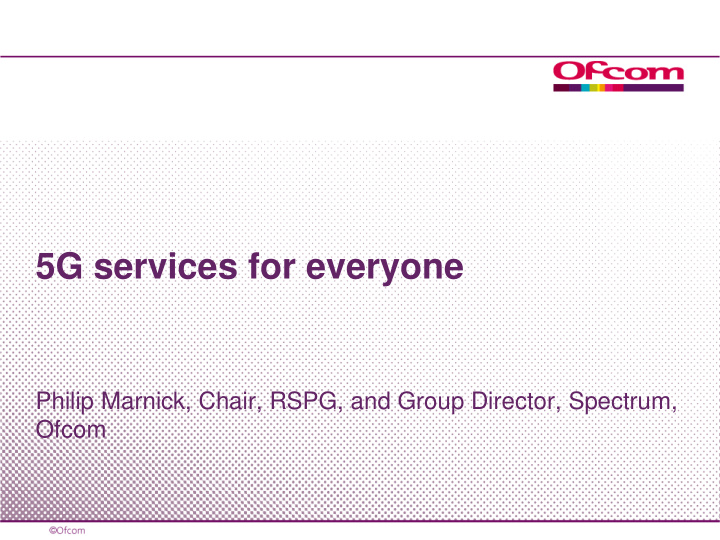



5G services for everyone Philip Marnick, Chair, RSPG, and Group Director, Spectrum, Ofcom
Debate on 5G has focused on three areas Broadband++ high throughput ..and what mm-Wave about coverage? Massive-MIMO Densification […] New MAC Waveforms Lean design D2D Multihop Distributed computing Waveforms Critical Resilient architecture […] M2M […] communications low cost low latency low battery consumption high reliability 2
5G will bring new services and bigger, faster versions of existing services 3
How do we ensure 5G services will reach all users? Rural areas: Enhancing macrocell capabilities to provide 5G services In areas with a small number of users mmWave region Evolution of current systems below 6 GHz High reliability and/or low latency Massive IoT applications 4
A diverse spectrum toolbox will cater for heterogeneous networks in 5G 900 800 700 1.4GHz 1800 2100 2.3GHz 2.6GHz 3.4GHz 3.6GHz In use or in the hands of mobile operators Current implementation w Possible future bands Refarming Possible 5G? 2G/3G/4G to 5G? plus mmWave 66GHz 25GHz 32GHz 40GHz 45GHz 5
We are considering bands wider than 1 GHz and with good potential for global harmonisation… Bands in the agenda for WRC-19*: Band Total size Many countries opposed specific bands at WRC where refarming 24.25-27.5 GHz 3.25 GHz would be difficult for them. 31.8-33.4 GHz 1.6 GHz Some bands received support 37-43.5 GHz 6.5 GHz from all regions, an indication that 45.5-50.2 GHz 4.7 GHz usage of these bands is low 50.4-52.6 GHz 2.2 GHz worldwide: 32 GHz, 66 GHz (in bold). 66-76 GHz * 10 GHz *Some of these bands are broken up in sub-bands in the 81-86 GHz 5 GHz agenda text 6
Greater number of cells means a greater number of backhaul connections We need to complement fibre with fatter wireless backhaul Fibre backhaul here Wireless Backhaul here Mesh architecture Ofcom will conduct a review of our fixed links strategy in Q2 here
Recommend
More recommend